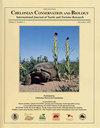A Short Review of the International Trade of Wild Tortoises and Freshwater Turtles Across the World and Throughout Two Decades
IF 0.8
4区 生物学
Q3 ZOOLOGY
引用次数: 31
Abstract
Abstract The CITES (Convention on International Trade in Endangered Species of Wild Fauna and Flora) data set for the years 1990–2010 were analyzed to depict the main patterns of trade for tortoises and freshwater turtles of wild origin. About 2 million wild individuals were traded over 20 yrs of monitoring, with 48 species (of 335 turtle species in total) belonging to 10 distinct families being regularly traded and over 100 being at least occasionally traded. Most of the traded specimens belonged to the families Testudinidae, Geoemydidae, Emydidae, and Trionychidae (about 93% of trade). The trade of wild individuals reached its peak in the early 2000s, with this pattern being stronger in the Asian region. After the years 2003–2005, there was a substantial decrease in the number of wild exports from the Asian region, with a remarkable growth in the export numbers from the Nearctic region. It is unknown whether the reduction of exported Asian region turtle numbers depended on 1) CITES regulation and supervision or 2) a collapse of the wild populations. There were uneven frequencies of wild turtles traded by biogeographic region, with a higher amount of traded wild turtles coming from Asian and Palearctic regions. There were 107 exporting countries, with Malaysia, the United States, and Indonesia being the most important countries in the trade (each one responsible for over 20% of trade). Overall, there were 66 importing countries, with the most important being the United States (17%), China (15%), and Hong Kong (12%). The conservation implications of the observed patterns are discussed.二十年来全球野生陆龟和淡水龟国际贸易的简要回顾
摘要对1990-2010年《濒危野生动植物种国际贸易公约》(CITES)数据集进行了分析,描绘了陆龟和野生淡水龟的主要贸易模式。在20年的监测期间,大约有200万只野生海龟被交易,其中48种(总共335种海龟)属于10个不同的科,定期交易,100多种至少偶尔交易。交易标本以绒猴科、地猴科、地猴科和三爪猴科居多(约占交易总量的93%)。野生个体贸易在21世纪初达到顶峰,这种模式在亚洲地区更为强烈。2003-2005年之后,亚洲地区的野生出口数量大幅减少,而新北极地区的出口数量显著增长。目前尚不清楚亚洲地区出口海龟数量的减少是否取决于1)CITES的法规和监督,还是2)野生种群的崩溃。不同生物地理区域的野生龟交易频次不均匀,亚洲和古北地区的野生龟交易频次较高。有107个出口国,其中马来西亚、美国和印度尼西亚是贸易中最重要的国家(每个国家占贸易的20%以上)。总体而言,共有66个进口国,其中最重要的是美国(17%)、中国(15%)和香港(12%)。讨论了观测模式的守恒含义。
本文章由计算机程序翻译,如有差异,请以英文原文为准。
求助全文
约1分钟内获得全文
求助全文
来源期刊
CiteScore
1.70
自引率
14.30%
发文量
17
审稿时长
>12 weeks
期刊介绍:
Chelonian Conservation and Biology is a biannual peer-reviewed journal of cosmopolitan and broad-based coverage of all aspects of conservation and biology of all chelonians, including freshwater turtles, marine turtles, and tortoises. Manuscripts may cover any aspects of turtle and tortoise research, with a preference for conservation or biology. Manuscripts dealing with conservation biology, systematic relationships, chelonian diversity, geographic distribution, natural history, ecology, reproduction, morphology and natural variation, population status, husbandry, community conservation initiatives, and human exploitation or conservation management issues are of special interest.

 求助内容:
求助内容: 应助结果提醒方式:
应助结果提醒方式:


